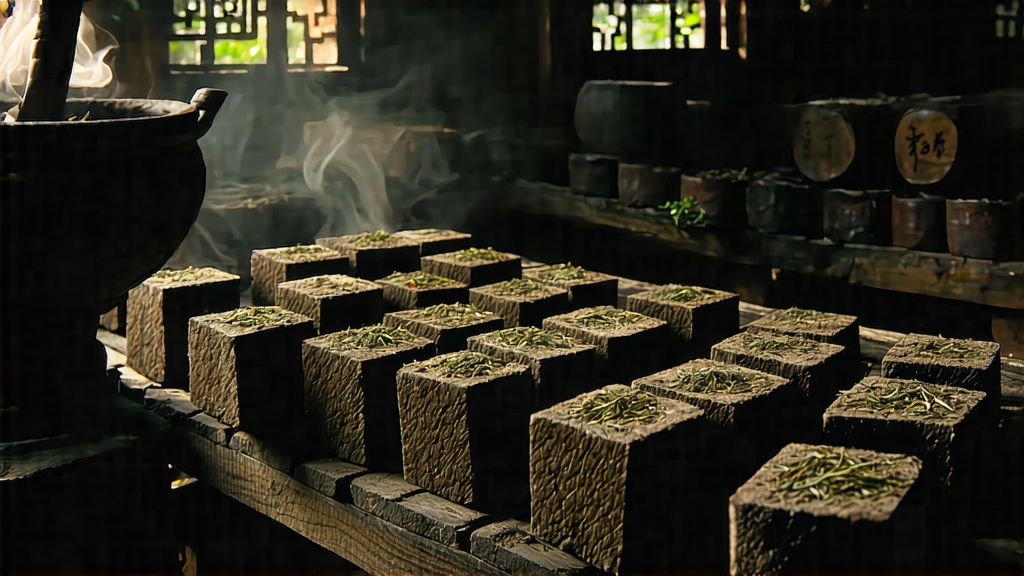
Tucked away in the humid mountains of southern China’s Guangxi Zhuang Autonomous Region, Liu Bao tea has spent four centuries quietly fermenting its way into the hearts of Cantonese merchants, Southeast Asian dockworkers, and, more recently, global tea connoisseurs. While Pu-erh often hogs the limelight, Liu Bao is the mellow, earthy cousin that Cantonese grandfathers still call “the oil of the throat,” a reference to the lubricating sensation it leaves after a dim-sum feast. To understand Liu Bao is to watch history dissolve in a cup: caravan bells on the Tea Horse Road, the creak of riverboats on the Xi Jiang, and the whispers of warehouse walls where 50-year-old bricks continue to breathe.
History: From Border Tribute to Dockside Currency
Liu Bao takes its name from the old postal town of Liu Bao in Wuzhou prefecture, the historic port where Yunnan, Guangdong, and Guangxi converge. During the Qing dynasty, pressed baskets of dark leaves were levied as “tribute” to the imperial court, but the tea truly came alive when Cantonese merchants discovered that the long, hot voyage down the Pearl River and across the South China Sea actually improved the flavor. By the late 19th century, Liu Bao had become a form of ballast—literally and economically—on ships bound for Singapore, Kuala Lumpur, and Jakarta. Dockworkers were often paid in tea, and Straits-Chinese families adopted it as a post-partum tonic, believing its “warm” energy expelled wind and dampness from the body. World War II disrupted the trade, and Liu Bao slipped into obscurity until the early 2000s, when vintage baskets began resurfacing in Hong Kong tea auctions, fetching prices that rivaled aged Pu-erh.
Terroir and Leaf: Where Camellia Sinensis Meets Subtropical Mist
Guangxi’s low-latitude mountains trap monsoon clouds between the Dayao and Yunkai ranges. The native large-leaf cultivar, locally called “zhong ye zhong,” develops unusually thick cell walls packed with polyphenols and soluble sugars—ideal substrates for microbial fermentation. Farmers pick one bud plus the third or fourth leaf, the so-called “lao ye” (old leaf) that would be too coarse for green tea but provides the lignin and cellulose that microbes adore. After harvest, the leaves are carried in bamboo baskets down mist-shrouded footpaths to village courtyards where the real alchemy begins.
Craft: The Secret Life of Wet Heat
Liu Bao belongs to the “hou fā jiào” (post-fermentation) family, but its technique predates the modern “wo dui” (wet piling) method made famous by ripe Pu-erh. The traditional Guangxi protocol, now protected under China’s National Intangible Cultural Heritage list, involves seven meticulous stages:
- Withering under subtropical sun for 30–40 minutes to reduce moisture to 65 %.
- Kill-green in dragon-eye wood-fired woks at 280 °C for exactly four minutes; the rapid high heat locks in a subtle longan sweetness.
- Rolling on bamboo trays to bruise the leaf edges without breaking the veins, encouraging future microbial entry.
- Sun-drying on raised racks for an entire day, during which UV light triggers non-enzymatic browning.
- Pile-fermentation: the leaves are heaped 70 cm high inside a humid warehouse, sprayed with mineral-rich spring water, and covered with jute sacks. Internal temperature is monitored daily; when it hits 55 °C the pile is turned, a ritual repeated every five days for six weeks. The dominant microflora shift from Aspergillus niger to beneficial yeasts such as Blastobotrys adeninivorans, producing the tea’s signature “betel-nut” aroma.
- Steam-pressing into 40 kg bamboo baskets lined with untreated banana leaves; the slight alkalinity of the leaf lining buffers pH and fosters a continuous micro-fermentation.
- Warehouse aging for a minimum of three years in sub-tropical humidity; traditional storerooms are built from volcanic tuff blocks that “breathe,” allowing a slow exchange of air while keeping mold at bay.
Modern factories replicate the climate with underground cellars, but veteran tea masters insist that only the natural swing between 22 °C winter nights and 32 °C summer days can coax out the deep jujube and camphor